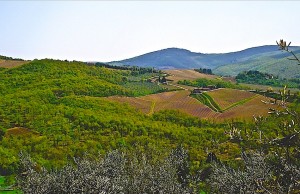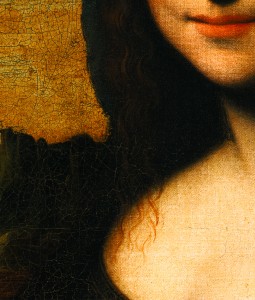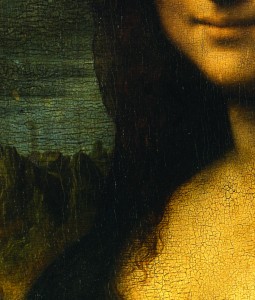“Human subtlety … will never devise an invention more beautiful, more simple or more direct than does nature, because in her inventions, nothing is lacking , and nothing is superfluous.” Leonardo da Vinci
For each Mona Lisa copy that exists, there would have had to be an original on which the copy was based; and there are countless copies, imitations, and versions on the theme of Mona Lisa. As long ago as 1952, to mark the 500th anniversary of Leonardo’s birth, an official count turned-up 61 variations (at least 72 according to Angela Ottino della Chiesa). No doubt more have been added to the list since then. Regardless, the quantity is almost irrelevant; the evidence in this book shows that only two versions could have been by Leonardo da Vinci. It is argued here that all the others are based on these two originals. Of the many copies of Mona Lisa, some have characteristics that are specific to either the ‘Earlier Mona Lisa’ or the Louvre ‘Mona Lisa’; others have details that actually show characteristics of both originals. After many years studying Leonardo’s paintings, one comes to quickly recognise the unique hallmarks of the master: his brushwork, composition and structure, palette, innovation, lighting, and his extraordinary talent in not only accurately reflecting the personalities of his subjects, but his ability, frequently lauded by the poets and writers of the day, to bring his subjects to life: to blend art and nature as one. His work is virtually impossible to accurately replicate: sooner or later the copyist will err. Few people before or since, in any profession, have been able to accumulate the wealth of experience in so many fields upon which to draw inspiration.
When comparing the two versions side-by-side, one is instantly confronted with some very significant differences, all of which lead to the inevitable conclusion that they were intended to be two separate portraits from the outset.
SIZE
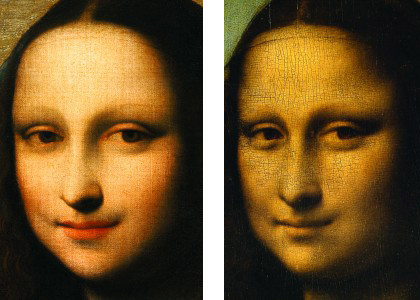 Perhaps the most obvious difference is in the sizes. The ‘Earlier Mona Lisa’ is quite a bit larger: the width is c.64.5cm, and the height is c.86cm.
Perhaps the most obvious difference is in the sizes. The ‘Earlier Mona Lisa’ is quite a bit larger: the width is c.64.5cm, and the height is c.86cm.
The wood panel of the Louvre ‘Mona Lisa’ is slightly uneven: according to the Louvre’s own measurements, the width varies between 53.3cm at the top, and 53.4cm at the bottom. The height is 79.2cm on the right, 79.1cm on the left, and 79.4cm in the middle.
SUPPORT
The ‘Earlier Mona Lisa’ was executed on canvas; the Louvre ‘Mona Lisa’ on wood panel. [This distinction is treated in detail in the section: ‘Science and Mathematics’]
AGES OF THE SUBJECTS
The relative age of the ladies in the two paintings is a recurring theme throughout this whole discourse. There is evidently a significant difference with the earlier portrait, which represents Lisa in her twenties. The lady in the Louvre ‘Mona Lisa’ is at least 11 to 12 years older. It is most likely that the two portraits represent the same woman at different ages. [This matter is treated on other pages, including ‘The Regression Project’]
COMPOSITION
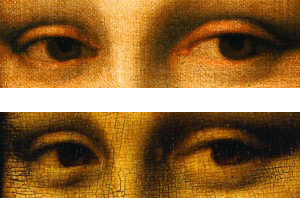
The overall compositions of the two paintings leave no doubt that they were conceived differently from the outset. The ‘Earlier Mona Lisa’ shows the young Lisa sitting in the open loggia, framed by two flanking columns. Unlike the Louvre ‘Mona Lisa’, the columns in the earlier painting formed part of the original composition.
In the Louvre version, in spite of its smaller size, the mass of the figure is brought forward, therefore its ratio relative to the area of the background is proportionately greater. She takes up more space, and this geometry is further accentuated by the effects of some of Leonardo’s glazing techniques perfected after 1508.
There are slight traces of pillars edging the painting, but these were probably never part of the original composition, having been painted on top of the background, and have little or no effect. Perhaps they were added by a restorer in consideration of the ‘Earlier Mona Lisa’. [See ‘The Vital Importance of the Columns’]
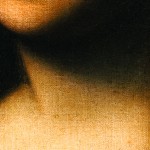
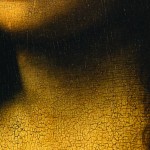
There is also a very subtle difference in the directional angles of the sitters. In the earlier version, Lisa is turned more towards the viewer; her head and right shoulder tilt slightly forward. The neck muscle is subsequently tightened, allowing the artist to accentuate this angle with the superb shaft of light on her neck. In the Louvre version, the lady sits more erect, allowing for the neck to appear more relaxed.
Leonardo also does not suffer incompetence gladly.
“Experience is never at fault; it is only your judgement that is in error in promising itself such results from experience as are not caused by our experiments.” Codex Atlanticus
The hands: The younger woman (L) has thinner hands, with more slender fingers, which are, especially the forefinger of her right hand, slightly more relaxed.
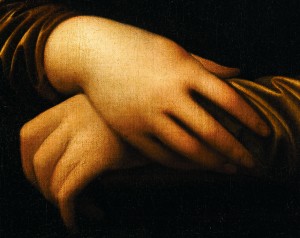
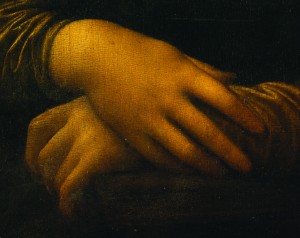
The hair: “Therefore make the hair on the head play in the wind around youthful faces and carefully adorn them with many cascades of curls”. Leonardo da Vinci
Faces and hands: A predominant characteristic of portraiture in Leonardo’s time was the contrast between the warmer tones of the hands and the pale complexion of the face and chest.
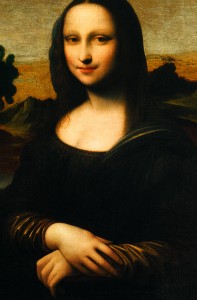
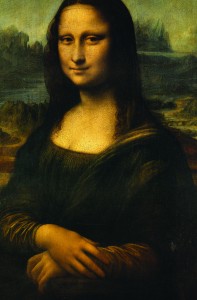
‘Hommage à Léonard de Vinci’, (Musée du Louvre, 1952) referring to the Louvre ‘Mona Lisa’ states that:
“ … the contrast between the warmer tones of the hands and the pale colour of the face and chest must have existed in the original … It seems that if a contrast existed, without doubt, it would not be that which we see today [in the Louvre version]… ”
This contrast does not exist in the Louvre ‘Mona Lisa‘, but it is perfectly preserved in the ‘Earlier Mona Lisa’. The discrepancy could indicate a transition of emphasis in the intervening years between the two portraits.
The Background Landscape 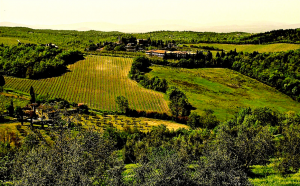
Leonardo’s landscape of the imagination, as rendered in his Louvre ‘Mona Lisa’, remains a mysterious enigma. The lower landscape is certainly more understandable, and many scholars have attempted to identify the location through recognition of the iconic bridge, over her left shoulder. The upper landscape however, is likely purely imaginary.
Professor Carlo Pedretti writes that: “The landscape in the painting, as in the Louvre ‘St. Anne’, is more in keeping with Leonardo’s scientific views of 1508 or later.” This comment goes to further explain the dating of this painting as being one of Leonardo’s later works. Interestingly, Leonardo employed the device of the background of massive rocky peaks on numerous occasions, going back at least as early as his ‘Annunciation’ of 1472-75, and the ‘Madonna of the Carnation’ from 1478-80.
The background in the ‘Earlier Mona Lisa’ is dramatically different. It remains largely unfinished, and the sky area is totally unfinished. As has been discussed previously, this element reflects exactly Vasari’s original and revised texts that the Mona Lisa to which he referred was left unfinished by Leonardo, and that there is no mention of a landscape of any kind. Furthermore, this painting of Mona Lisa is the only one that could be by the hand of the great master and that can be so identified. The cluster of trees on the left-hand side was likely originally reflected in a small blue lake. Though a trace of the underlying blue can still be seen, that area was completely overpainted during a subsequent restoration by a talent far removed from the original master. [see ref. to Oslo ‘Mona Lisa’ in The National Museum Of Art, Architecture And Design, Oslo]
Sir Kenneth Clark, having seen an image of the painting, writes in early 1943 that “its chief interest lies in its greater width, which allows for the inclusion of the pillars, which evidently formed part of of the original design.” This comment in turn also goes to identify the sitter as Florentine, and the dating of the work during Leonardo’s ‘Second Florentine Period’, after his return from Milan. Unfortunately, Clark never did get to see the painting.
